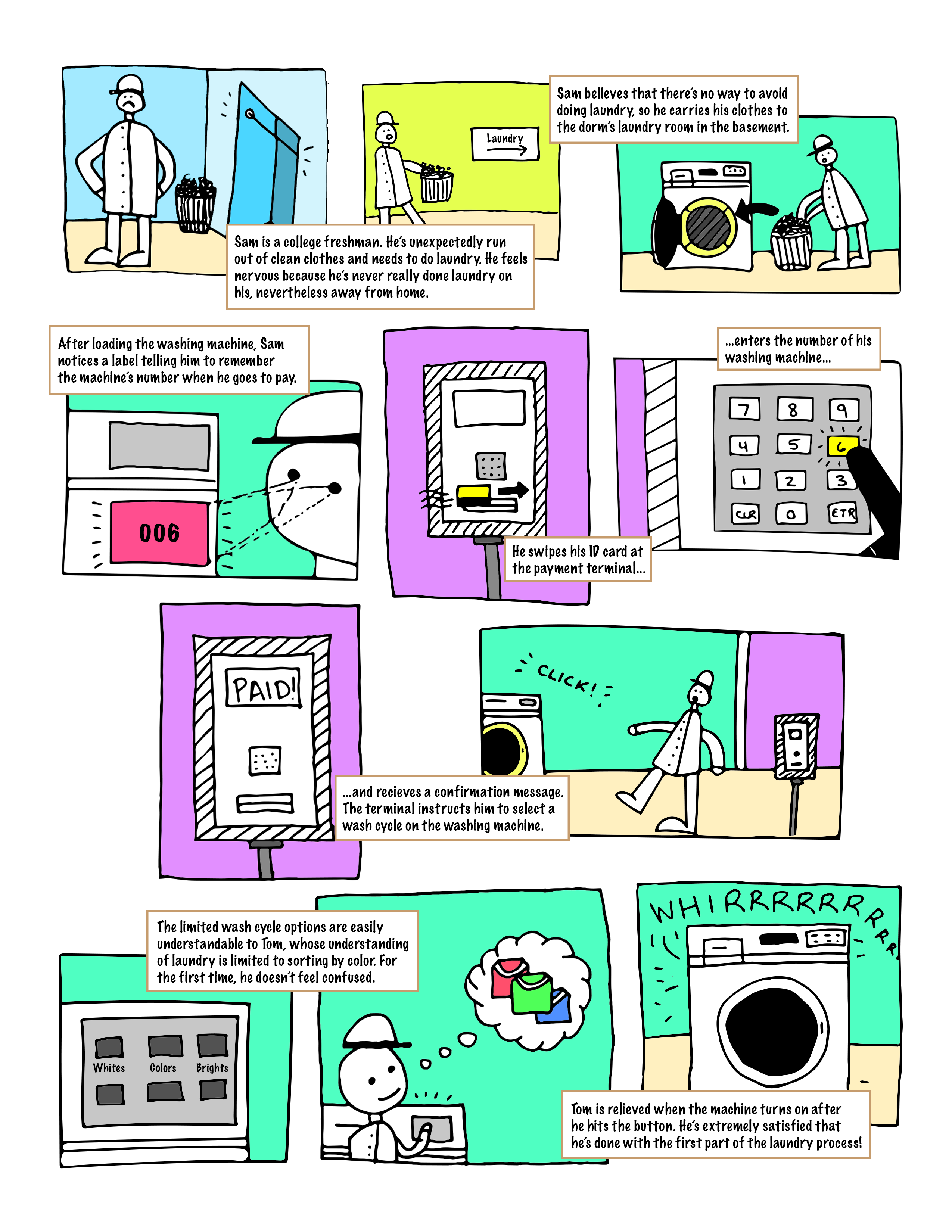The laundry room—whether you love it for what it can do or hate it for how long it can take to get out of it, it’s an unavoidable yet essential part of everyday life. At Brown University, I’ve heard stories about my peers’ experiences in the laundry room ranging from someone’s first-time doing laundry away from home to another having difficulty finding time to do it in the first place.
In this project, I construct two personas with corresponding mental models based on data collected from two sessions of observation in the laundry room in the Archibald-Bronson dormitory at Brown. I also present a storyboard depicting the process by which users use the machines specific to the Archibald-Bronson laundry room.
Interface Overview
Laundry at Brown involves two interfaces—the laundry machines and the payment terminals. This extra terminal is significant as it allows students to continue to use their Brown ID for all Brown-specific purchases. After a user loads a laundry machine, they walk to a terminal and swipe their ID to access their payment account. The terminal then prompts the user to enter the number of their laundry machine (found next to the machine’s door) via a keypad. Users can then start the machine by selecting one of six wash cycle options using a button panel on their laundry machine.
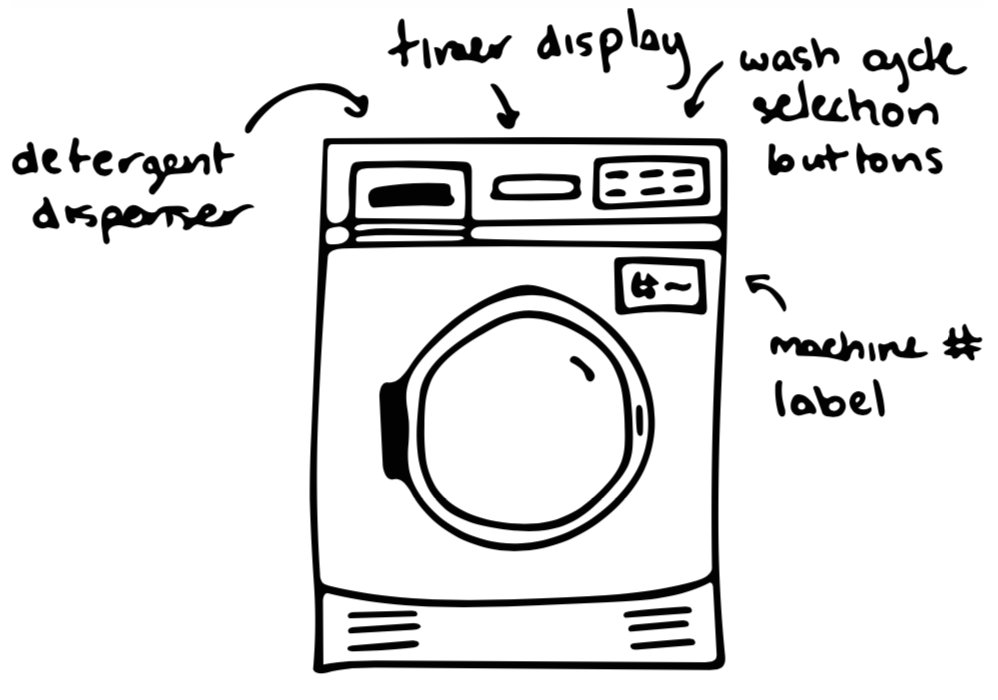
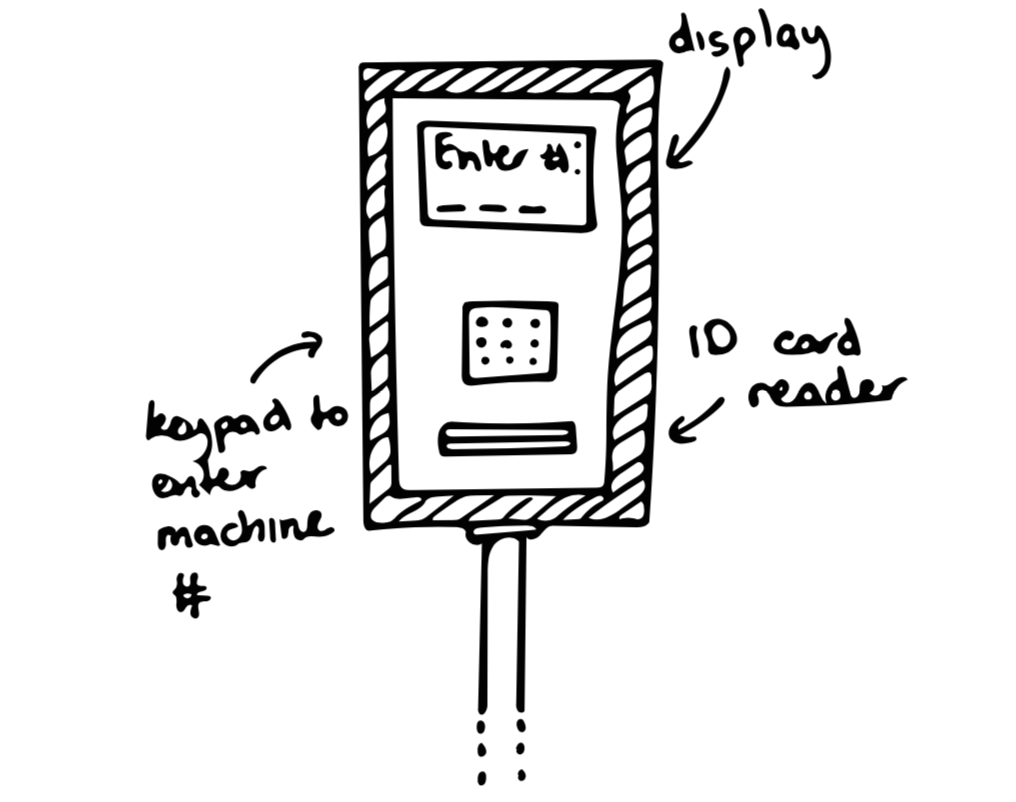
User Observations
I observed consenting participants in the laundry room as they went from putting their clothes in the washer to taking their clothes out of the dryer, and retained the following notes:
- Akari carefully pulled apart tangled clothes before placing them in the washer. Before moving to the payment terminal, she leaned in closely to see her machine’s number. After starting the machine, she ran out of the room while saying she had to do work.
- Elijah had to walk back to the machine to see the machine’s number because he apparently had forgotten what it was despite his verbal attempts to memorize it before walking to the payment terminal. He set a timer on his phone, left during the wash cycle, and came back several minutes before the cycle ended. He had less trouble paying for the dryer cycle.
- Lisa stayed in the laundry room while she waited for the washer to complete its cycle. She set a timer on her phone and worked on homework until the washer had completed.
- Ryan quickly dumped the clothes in his basket into the washer, then ran to the payment terminal. He spent approximately thirty seconds staring at the wash cycle buttons before finally selecting an option. He set a timer on his phone and left the room when it began, though he came back about 45 minutes after the cycle had ended.
- Lawrence stayed in the laundry room while waiting for both the washer and the dryer to complete their cycles. He had to go back to the machine to see its number in order to use the payment terminal, and verbally expressed confusion on which cycle option (“Whites”, “Colors”, “Brights”, etc.) he was supposed to select.
- Sumu folded his clothes before placing them into the washing machine. He asked me for help on which cycle option to select. He left the room, and came back about thirty minutes after the laundry machine had ended. He folded his clothes again before placing them into the dryer and asked me for help on which dryer options to select. He left the room and came back just as the dryer was ending its cycle.
Interviews
Which cycle option button (“Whites”, “Colors”, “Brights”, “Perm Press”, “Delicates”) did you press when washing your clothes? Why? Have you ever seen other people confused about the buttons?
Most users simply stated that they pressed whichever button matched their clothes, though all users said they had only ever pressed the “Whites”, “Colors”, or “Brights” buttons. All users noted that they all knew from past experience or from what other people told them that they were supposed to sort their clothes by color before washing them. Sumu and Lisa specifically stated that they were confused by the difference between the wash cycle options.
What do you usually do when your laundry is running? On average, how much time is your laundry in the machine after the cycle time has elapsed? Do you ever see other peoples’ clothes waiting unattended?
All users said they did homework while waiting, though Lisa and Lawrence said they work in the laundry room instead of their dorm room like the other users. Lisa specifically noted that she doesn’t like leaving her laundry unattended, because she’s concerned that someone might steal it or the washer will mess it up in some way. Ryan also noted that he was in a rush to finish homework before a midnight deadline at the time we interviewed him. All interviewees stated that they set timers to remind them to come back to get their clothing immediately when their wash cycles are complete, though our observations show that some users returned well after their machines had run their course.
Do you ever see other people have trouble using the payment terminal? What do you think about having separate balances for meals, prints, laundry, etc.?
While no one had any problems with the payment terminal itself, opinions on the split account system were relatively split. Akari, Elijah, and Ryan stated that they didn’t really have any opinion on the payment system. Lisa stated they she liked it that accounts were divided into meals, laundry, etc., because it helps her keep everything organized in her mind. Lawerence and Sumu felt the opposite way, saying that the split account system required them to keep track of too many things.
Mental Models and Personas
Using the information from my user observations and interviews as detailed above, I developed two personas, each with their own set of mental models, to describe users’ perceptions of the laundry machines at Brown. I also developed empathy maps for each persona for a more visual understanding of each user’s thought process and character.
Mental Model 1: Sam
Sam is an 17-year-old freshman planning to concentrate in music. Having relied on his mother to take care of all the chores he never wanted to do for his entire life, Sam realized when he ran out of clean clothes one week into college that he’d need to start doing things on his own.
But Sam’s recollection of his mother saying that he must sort clothes by color allows him to use the dorm laundry machines easily. Since three of the machines’ wash cycle options are simply “Whites”, “Colors”, and “Brights”, he quickly translates his mental model to the limited options the machine interface presents. Sam just has to look at the color of the clothes he’s washing in order to determine which button to press.
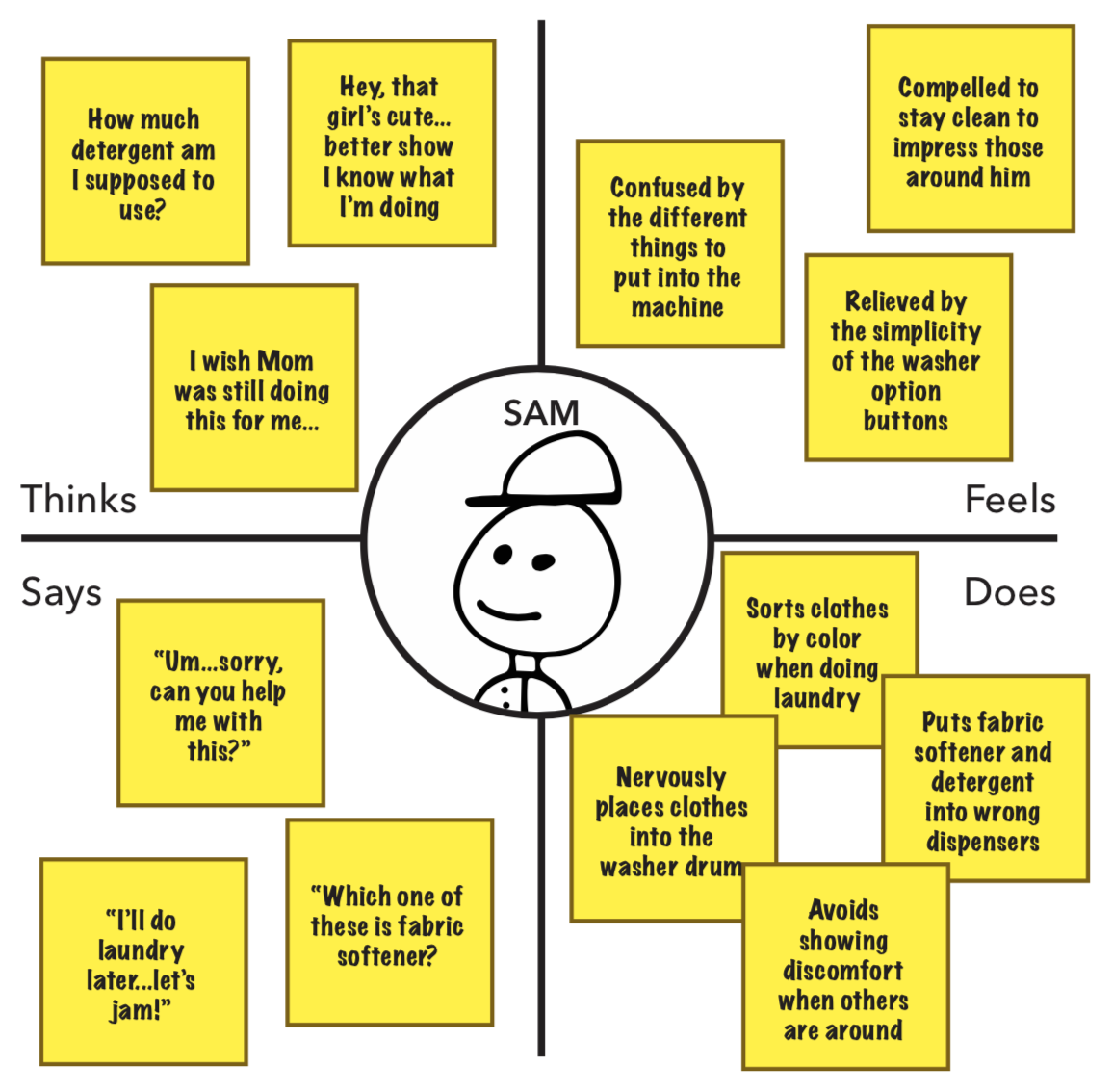
Mental Model 2: Brianna
Brianna is a 19-year-old sophomore at Brown. After a year of pursuing a Computer Science concentration and nightly track-and-field practices, Brianna’s precisely organized her schedule such that she can do everything she wants to. Brianna blocks out a significant amount of time for laundry every week, because she’s found that she needs more time to decipher an interface she finds confusing.
Brianna’s not used to the simplified configuration options of the laundry machine in her dorm. Not able to set individual settings such as cycle length, temperature, and spin intensity, she’s confused by the wash cycle buttons’ lack of detail. Despite her experience doing laundry by herself at home, Brianna’s unable to tell the difference between the cycle types, so she spends extra time thinking about what each wash type could mean.
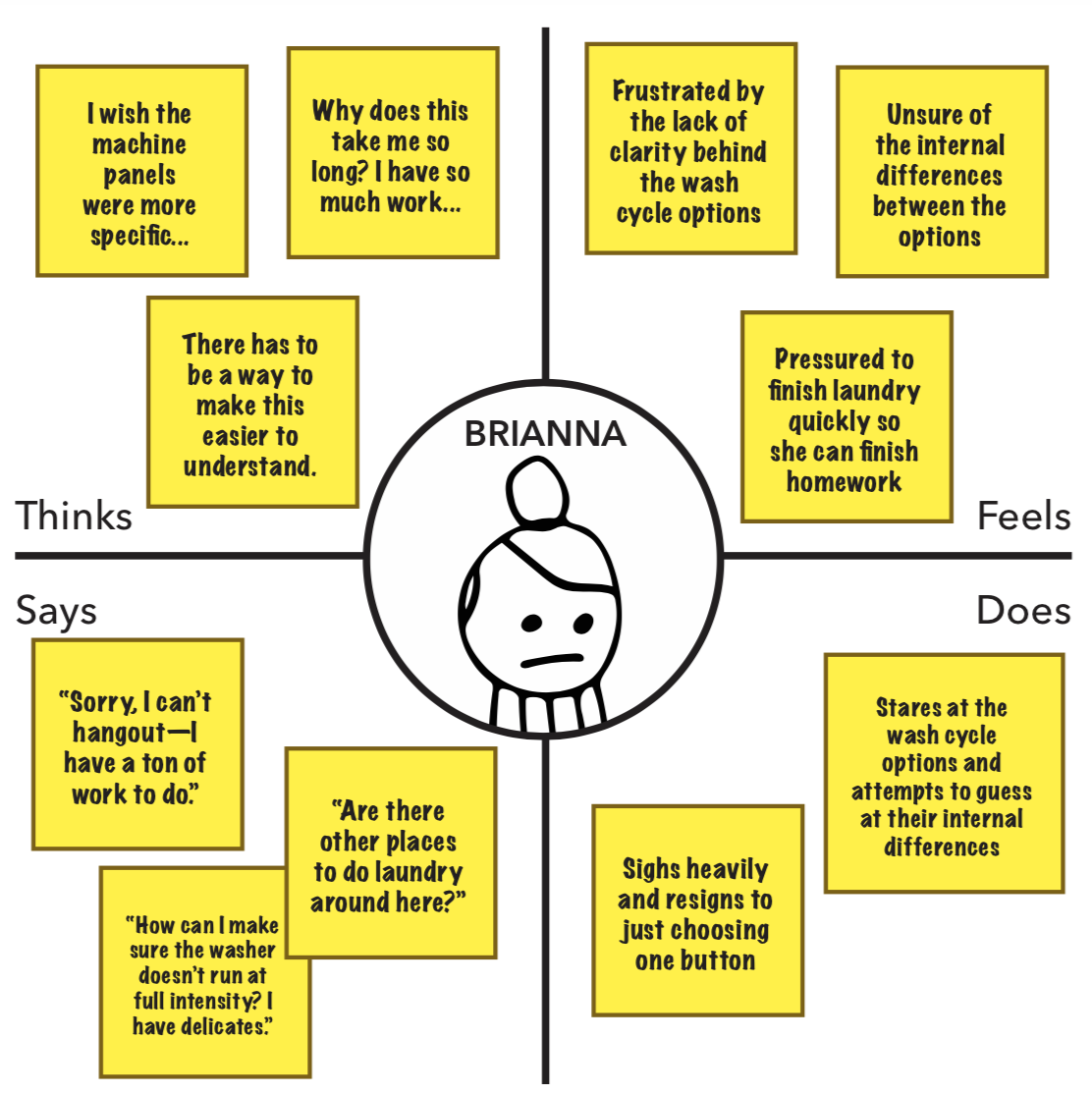
Storyboard
As a final step in the project, I created a storyboard for Sam’s user journey when he goes to use the laundry machine. The user journey depicted fits Sam’s persona for the following reasons:
- It captures his relaxed personality via his lack of urgency in making sure to clean his clothes.
- It conveys his nervousness in completing a task that he’s unknowledgeable about but his realization that there’s no other way around the issue.
- It demonstrates how Sam’s simplified understanding of how laundry works fits well with the provided interface, which ultimately allows him to fulfill his goal of self-cleanliness by washing his clothes.
